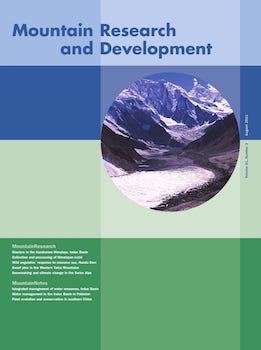Sacred Natural Sites: Conserving Nature and Culture, edited by Bas Verschuuren, Robert Wild, Jeffrey A. McNeely, and Gonzalo Oviedo. London, United Kingdom: Earthscan, 2010. xxvi + 310 pp. US$ 49.95, £ 29.99. ISBN 978-1-84971-167-8.
Whether you consider a 60,000-year-old Neanderthal burial site or move ahead 10,000 years to Australian sacred sites, this book tells you just about everything you may want to know about sacred natural sites—and if it fails to do so, the extensive reference lists will guide you to answers to any questions still burning in your mind. It begins by defining sacred natural sites as “areas of land or water having special spiritual significance to people and communities” (Oviedo and Jeanrenaud 2007). The word “natural” distinguishes them from other sacred sites, such as temples, churches, and mosques, although many of the sites studied were tended, if not actually manicured, by the local people, and hence the degree of naturalness varied considerably. Similarly, a “site” in this context varies widely and could refer simply to a rock or tree, often the home of a local spirit that was left untouched even though the surrounding area might have been cultivated, used to collect firewood, built on, or logged. The underlying message is that many of these sites are endangered by various forms of anthropogenic intervention, with the effects of climate change posing the greatest threat.
The book is laid out in 4 sections. The first deals with the science and spirituality of sacred natural sites, including: a review of the literature on their conservation and biodiversity; the impacts of global changes on mountain sites; issues dealing with the stewardship of sacred trees and groves; numinous sacred sites (spirits, deities, or a divinity living in sacred sites that have magic or supernatural powers); and arguments for considering the biocultural values (the interaction between natural and cultural values) of the sites to encourage conservation.
The second section deals with the role of these areas regarding potential and existing tourism, the conservation of biodiversity, and the maintenance of cultural heritage. Examples come from throughout the world, including the UK, Nepal, China, West Cameroon, the Niger Delta, Suriname, and Jamaica. A mixture of social science and ecological methodologies are presented along with data analysis and results; this widens the appeal of the book to both social and natural scientists. The studies include the sustainable management of individual species as well as the biodiversity value of these areas. A recurring theme is that, although local people may try to manage their resources sustainably, external pressures and the fact that they often do not own the land they are managing are major issues. This aspect of ownership is a key one throughout the book; many of these sites lack any protection in law, an issue that needs to be addressed.
Section 3 deals with international recognition and global governance and, in particular, the fact that, although thousands of sacred national sites are known, there is still no international inventory. However, the point is also made that such an inventory would be a double-edged sword: some sites are preserved because they are unknown to most people and, not surprisingly, many caretakers do not wish their site to become the next attraction on a tourist trail. However, this emphasizes an additional value of these sites: in addition to preserving culture, history, and biodiversity, many sacred sites earn income for local people, regions, or countries, and other sites have the potential to do so.
This aspect is further considered in Section 4, which covers the role of tourism, indigenous community survival, and issues relating to sustainable management. Here the conflict between traditions and the ignorance of tourists and their often inappropriate behavior are highlighted, with the acknowledgment that the initial euphoria in anticipation of potential income generation from tourism may not last as the income does not always live up to expectations. Suggested ways to support local communities include the provision of better infrastructure, capacity-building, education, finance, and often some form of regulation to help them manage visitors. The emphasis is on helping communities take control of any potential or existing tourism.
How would you use this book? First, as an ecologist and ecotourism specialist, I found the case studies and reference lists most interesting and of potential use for myself and my students. It is well laid out, with a contents summary for each section and chapter, enabling you to quickly see what might be relevant to your specific needs or just interesting to read. The final chapter gives an excellent summary of the topic, with conclusions on how to sustain sacred natural sites to conserve nature and culture; these points are further expanded to include key issues as well as their causes and potential solutions. The downside of the book is that, because each chapter tells its own story, the issues and conclusions are similar; hence, the book is repetitive if one reads it from cover to cover. Therefore, I would suggest that it is a book to dip in and out of, rather than as a continuous read. Overall, it is an interesting book to have on your shelf, providing an excellent reference text for students, academics, and other individuals interested in natural sacred places. I would hope that it might also appear on the desks of legislators—or that it might at least be summarized by their staff in their briefs, to highlight the importance and vulnerability of these amazing places.
Open access article: please credit the authors and the full source.





